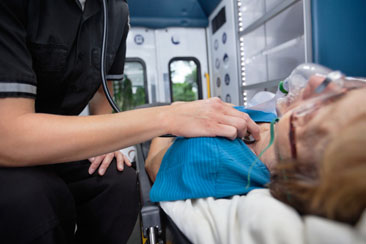 Mobile video conferencing helps businesses reduce overheads, increase revenues, enhance employee and customer engagement, and retain the best staff. In health care, mobile video conferencing can save lives. According to a recent report in Medical News Today, a mobile videoconferencing system that allows paramedics accompanying patients in ambulances to interact with doctors could help stroke patients receive timely treatment and reduce the risk of disability and death.
Mobile video conferencing helps businesses reduce overheads, increase revenues, enhance employee and customer engagement, and retain the best staff. In health care, mobile video conferencing can save lives. According to a recent report in Medical News Today, a mobile videoconferencing system that allows paramedics accompanying patients in ambulances to interact with doctors could help stroke patients receive timely treatment and reduce the risk of disability and death.
Researchers from the University of Virginia (UVA) Health System in Charlottesville arrived at this conclusion based on their study of a mobile conferencing system through which paramedics in ambulances discussed the patient’s condition with doctors using computer tablets. Their study was published in the journal Neurology.
A stroke occurs when blood flow to an area of the brain is cut off. An ischemic stroke is the most common type and involves a blocked blood vessel. Stroke is the fifth leading cause of death in America and a major reason for adult disability. Symptoms include difficulty walking, paralysis, weak/stiff muscles, coordination problems, weakness of one side of the body, paralysis of one side of the body, and blurred vision.
Getting medical help in the early minutes after symptoms start is crucial to reduce complications and improve chances of survival. Quick diagnosis means the patient can be given medication to dissolve the clot or have surgery performed to remove the blockage and restore blood supply to the brain.
As an ischemic stroke is a critical emergency, the first line of action is to call an ambulance. Modern mobile stroke units (MSUs) are specialized ambulances equipped with a mobile blood lab, a CT scanner (head) and telemedicine equipment that paramedics can use to send diagnostic images to neurologists at the hospital. The UVA study assessed a low-cost computer tablet in the ambulance. Called Improving Treatment with Rapid Evaluation of Acute Stroke via Mobile Telemedicine (iTREAT), the tablet is suction-mounted to the wall of the ambulance. It allows the doctor to confer with the patient and the paramedic through encrypted video signals. The researchers found that 96 percent of the iTREAT assessments were as effective as evaluations performed at the bedside in the hospital. Such conferencing would facilitate better decision-making while the patient is in the ambulance so that quick, quality treatment can be provided.
Whether it’s in a stroke unit or in a hospital setting, proper measures and tools are necessary for the shared understanding of a patient’s care history. This will promote continuous and efficient intra- and interdisciplinary communication and decision-making about the patient’s future care. Medical transcription companies play a crucial role in facilitating clinical documentation and record keeping for all specialties, including neurology. They provide customized EHR-integrated neurology transcription services to ensure the information flow that is needed to ensure the continuity, quality, and safety of care as well as meet legal requirements, accountability, medical billing, and more.


